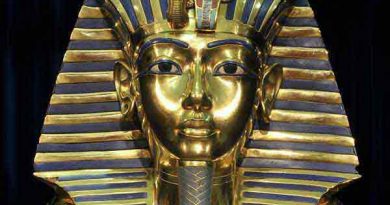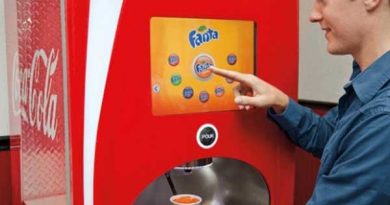What is Kano Model Analysis? And How to Conduct it.
Designing a product can be challenging. The array of features and designs to select and eliminate is daunting, especially when stepping out into the field with customer satisfaction and delight in mind. There are endless questions and possibilities at the early stage of the design thinking process. How will the product perform, or is this service a financial drain? Will customers respond well to this shiny new product? The Kano Model helps us to identify the answers to these questions.
While the design research and design iteration help us identify the consumer’s needs, we need a theoretical model to help us frame the questions we want to ask our consumers. Some companies already built a clear and accurate understanding of their clients and implemented their product development process through a design-driven culture inside their organisation. Think of Apple and Airbnb. Other companies may have yet to develop this clear understanding. The Kano Model can help companies as a tool to build this understanding, which they can use especially in the prototyping testing phase of the product.
What is Kano Model Analysis?
The Kano model is a theory that focuses on customer satisfaction, relying on emotional responses to product quality and functionality. This model is simple but, more importantly, efficient and straightforward. It gains insight into how a customer responds to a service or product’s versatile features and attributes.
The Kano model analysis is a tool based on that theory that helps modify and enhance your products, focusing on servicing customer emotions during the product roadmap. This model was also known as “customer delight vs. implementation investment.” The essence of this tool is that a product is much more than just fulfilling its objective use. The basis of the Kano model analysis is the emotion between a customer’s response to various products and services ( Customer Journey Mapping: A Complete Guide for Designers).
Who Developed the Kano Model Analysis?
Professor Noriaki Kano, Tokyo University of Science, coined the Kano Model. He taught quality management and published his theory in 1984. The Kano model was built on three core values:
- A good-quality product will create loyalty between the customer and the company.
- Innovation is key to remaining relevant.
- Value for money is what keeps customers loyal.
Why would you Use Kano Analysis?
The question should rather be, why wouldn’t you? As mentioned above, designing a product or service can be daunting. It is challenging to narrow out the features and attributes of a product to figure out how you would want to define it. Suppose you’re designing an electronic device. As far as features go, there are an array of options. This is where the Kano model comes in. You would want your product to stand independently and display unique features. The product needs to be successful and exciting, so how will you sort out all this clutter of information and create a meaningful product and experience for the customers?
This brings me to the Kano model. It will sort out your priorities and narrow down which product features are desired, which are basic, and what brings value to the customer ( Empathic Design: The Most Difficult Simple Approach to Successful Design ).
When would you Use Kano Analysis?
This model can be most needed when there’s an array of features to wade through and insufficient clarity on the next step. The Kano model analysis assigns what features should be highlighted, keeping in mind the financial and time limitations of the tested feature. The Kano Model can be part of your research methods to get user satisfaction with existing product features. For new products, users can be used during the prototype testing phase during the design thinking process. The Kano Analysis is linked to different methods that can help us to identify the current problems, such as the 5 Whys Root-Cause Analysis., and the Thematic Analysis used to analyse user qualitative answers.
The Categories of Features in Kano Analysis
We’re going to delve deep into The Kano model categories, such as the questionnaire plus the satisfaction and functionality scale.
Kano’s Five Emotional Response Types
Noriaki Kano believed that customers had emotional responses to product or service features. He theorised these emotional responses by conducting a study on 900 participants to gather intel on this theory. Further on, he visualised the emotional response types.
- Must-be (or must-have) features
- Performance features
- Attractive features
- Indifferent features
- Reverse features
Although these emotional response types have been widely translated and studied, they have been given different names. They were called delighters/exciters, satisfiers, and dissatisfiers in English. The original thought dates back to Kano. They are also called:
- Threshold attributes (basics)
- Performance attributes (satisfiers)
- Excitement attributes (delighters)
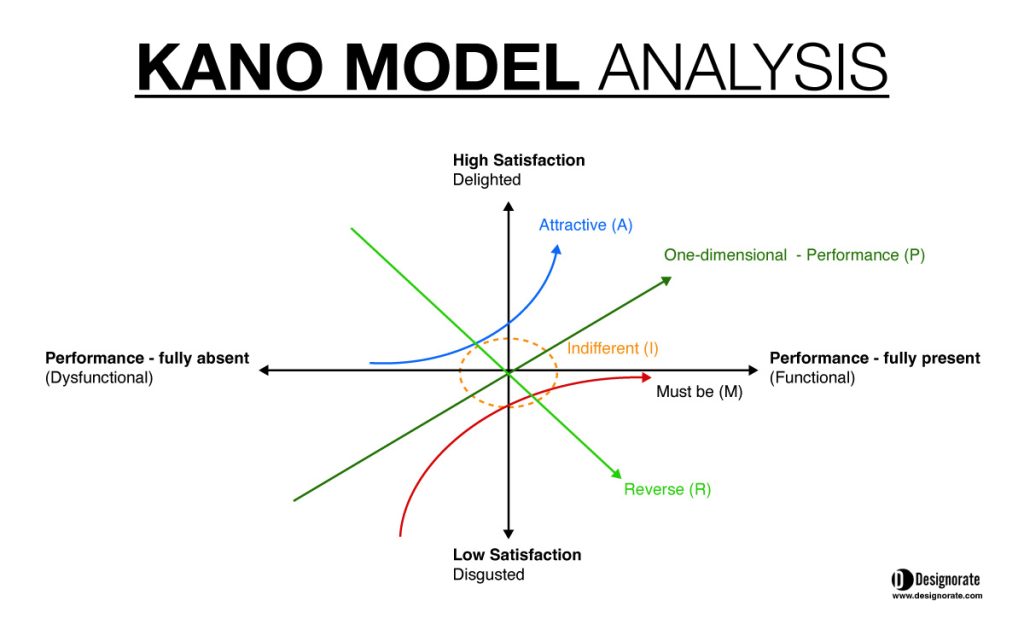
In addition, he also created a functionality scale, which was also called the investment, sophistication, or implementation scale. This scale’s purpose was to represent the functionality of a product or service based on what the customer thinks (How to use Card Sorting to Improve Service Design).
The Kano reaction graph scales the customer’s response to a feature, keeping customer satisfaction and product functionality in mind. This scale indicated satisfaction from the highest level to the lowest level of frustration. This is insightful input coming from a customer in response to a feature.
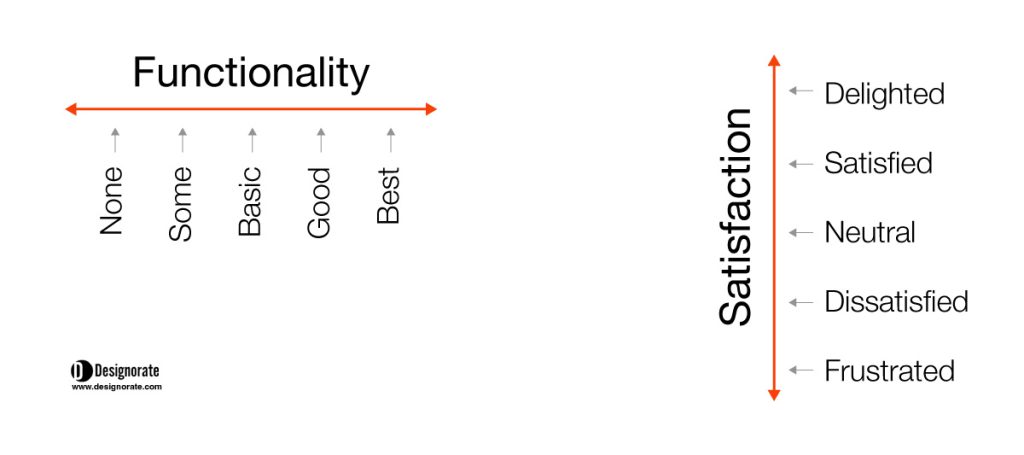
Satisfaction and functionality Scales
The Kano reaction graph scales the customer’s response to a feature, keeping customer satisfaction and product functionality in mind. This scale indicated satisfaction from the highest level to the lowest level of frustration. This is insightful input coming from a customer in response to a feature.
This image represents the functionality scale (otherwise called the investment, sophistication, or implementation scale). The scale reads none all the way to best. The scale provides insight into the product’s functionality. Can the product offer more? Has it really been shaped up to its highest quality? The customer can now let us know the point. If we take into consideration the Kano questionnaire responses and truly create a product panned out by the customer, the features and attributes can be determined by its satisfaction and functionality level. Product teams can put the data to use to ensure that the product will create loyalty between customers and the company and garner a positive response.
This image represents the functionality scale (the investment, sophistication, or implementation scale). The scale reads none all the way to best. The scale provides insight into the product’s functionality. Can the product offer more? Has it been shaped up to its highest quality? The customer can now let us know the point. If we take into consideration the Kano questionnaire responses and truly create a product panned out by the customer, the features and attributes can be determined by its satisfaction and functionality level. Product teams can put the data to use to ensure that the product will create loyalty between customers and the company and garner a positive response. The Kano model analysis has three categories assigned to products and services:
Must-Be Attributes (Basics)
In reverence to the image, the above threshold attributes are basic expectations. The minimum viable product is expected or required to have by a customer. No customer would find themselves excited or surprised by this feature, such as a jacket requiring a zip and a clock with a hand.
If you step into a customer’s shoes, these features are rendered invisible, but if they are faulty or useless, it will garner a negative response from the customer. Therefore, you see, the basics are an essential element to guarantee flawlessness. It is basic to expect a home to have a roof and walls and a diner to have utensils. With that being said, imagine if these features weren’t present. You would be sore if a restroom didn’t have water, but normally, you don’t think about it, do you?
When designing a product, we emphasise the wow factor, or the glitz and glam, but to ensure good-quality products and services, one must start with the basics.
One-Dimensional Attributes (Satisfiers or Performance)
Satisfiers features garner an immensely positive response from the customer. In the above image, they are also referred to as satisfiers. The shinier the features, the more customers are attracted. When making a purchase, the customer considers these features deeply, and they make quite the difference in this setting, or, as they say, more is good. More is what’s desired. Customers who buy a brand-new car receive brand-new seat covers and merchandise. These are game-changers for many buyers. Such gestures garner loyalty and high levels of satisfaction. These features can become the talk of the town. In simple words, when has free stuff not helped the case?
These features are not only desired but also garner a response when they are missing. These attributes can be overlooked and considered unnecessary, but customers respond positively when included in the product or service. If you book a hotel, you may be pleased to note that the linen is of fine quality, and the TV has multiple streaming options.
Attractive Attributes (Delighters)
Delighters are delightful for customers and can improve your product or service’s performance. The extra or somewhat extravagant features that customers did not know they even wanted are noticed when they’re not present, as they were not expected. For example, fresh flowers at your table when dining or complimentary chocolates greeting you in your hotel room. These attributes garner emotionally positive responses from customers. One must execute them well. If the customer’s basic needs aren’t being met and you push a delighter, this will result in frustration. This is something to keep in mind.
Nowadays, the competition is quite cutthroat, so delighters can be just the nudge your business needs to attract customers.
Indifferent features
Indifferent features do not make an impression on customers, much less garner a response. They go ignored, or in some cases, complex designs in attempts to create unnecessary features can create a nuisance, mostly a waste of time and resources with features that become absolute. These features are indifferent to most customers but tend to cost the company money.
Reverse features
As the name suggests, reverse features have the opposite effect on the customer; instead of causing customer satisfaction and delight, they become a nuisance, creating issues. Their absence may cause delight. That being said, the feature itself cuts away at the budget, doing the company no favours. Reverse features are intended to be game changers but end up being the opposite.
How Does the Kano Model Work? And How do you Use it?
Imagine you are designing a product with your team. You have a budget and a deadline; you must make crucial decisions to guarantee the customer’s emotional response to these products’ attributes. Your team would list the features or wow factors that
delight the customers. Budget accommodations need to be made. You get the statistics. It needs to be tactful and have a low failure expectation. That’s where you would need the Kano model, as these features will need to compete against each other in the following criteria:
Suppose they have the expected potential to satisfy customers versus the finances needed to fund them. In that case, this is the reason why the Kano Model is also known as the “Customer Delight vs. Implementation Investment” approach.
The Kano Model Questionnaire
As we read above, the Kano model has categories, which they assign to features. The Kano questionnaire has five options regarding how you feel about the feature based on five Likert scale points:
- Like it
- Expect it
- Don’t Care
- Live With
- Dislike
In reference to the five emotional response types, the Kano questionnaire can be used, and two positive questions about the functionality of the product feature:
- How do you feel if you have this feature?
- How would you feel if there was more of the feature?
And the other negative set of questions are based on the dysfunctionality of the feature:
- How do you feel if you do not have this feature?
- How would you feel if there was less of a feature?
These questions, with reference to the image above, can be answered in a point-noted chart. There are five categories from which you can choose, which narrow down how you feel about a certain feature or attribute. The answer of these questions can be mapped to the above five dimensions as shown in the figure below:
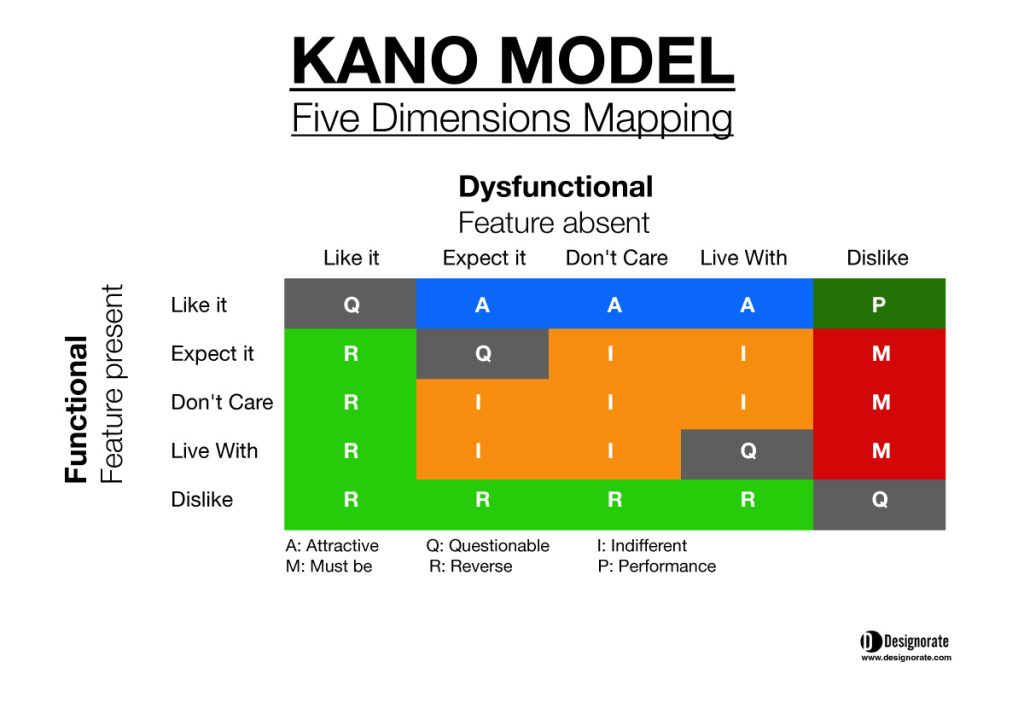
For example, I am a product designer attempting to create lights sensitive to movement to be placed on porches or gardens. It is expensive to create products, especially considering the built-in sensors. How can I know what this product needs or customers’ responses to its various attributes?
Advantages and Disadvantages of Kano Model Analysis
Applying the Kano Model can benefit businesses, but we need to be clear about both the pros and cons of applying it in practice. The advantages of applying the Kano Analysis include:
- The Kano model knows what the customer needs even when the customer does not. It can identify unnecessary and necessary
- It can wade through the plethora of options and pick the features that will garner a positive customer response.
- Kano gives insights into the feature performance among all the other attributes. It narrows down your work for you.
The disadvantages of the Kano model analysis include the following:
- Time consumption is an issue when performing a Kano model analysis. It might differ from how you want to learn if you’re in a time crunch.
- The Kano model analysis does not consider financial limitations. Given budget cuts or limited resources, it might be unrealistic to apply certain features.
- Customers might not understand the questions. They wouldn’t know they wanted a feature until they saw it.
A point to keep in mind when creating or adding features to a product is innovation. Customer demands and needs change over time, such as the ordinary phone. There was a time when smartphones and tablets were not the norm. It was all the rage when Apple released the first touchscreen phone, and the world shifted. Nowadays, a touchscreen phone is a basic attribute. The point is that innovation is key.
Kano model questionnaire:
As we read above, the Kano model has categories, which they assign to features. The Kano questionnaire has five options regarding how you feel about the product.
- I like it.
- I expect it.
- I am neutral.
- I can tolerate it.
- I dislike it
In reference to the five emotional response types, the Kano questionnaire can be used, and two crucial questions should be raised.
- How does this particular feature feel to you?
- How would you feel if this feature were not present?
These questions, with reference to the image above, can be answered in a point-noted chart. There are five categories from which you can choose, which really narrow down how you feel about a certain feature or attribute.
For example, I am a product designer attempting to create lights that are sensitive to movement to be placed on porches or gardens. It is expensive to create products, especially considering the built-in sensors. How can I know what this product needs or customers’ responses to its various attributes?
Advantages and disadvantages of kano analysis:
- The Kano model knows what the customer needs even when the customer does not. It can identify unnecessary and necessary
- It can wade through the plethora of options and pick the features that will garner a positive customer response.
- Kano gives insights into the feature performance among all the other attributes. It narrows down your work for you.
Disadvantages of Kano model analysis:
- Time consumption is an issue when performing a Kano model analysis. If you’re in a time crunch, it might not be the way you want to lean.
- The Kano model analysis does not consider financial limitations. It might be unrealistic to apply certain features given budget cuts.
- Customers might not understand the questions. They wouldn’t know they wanted a feature until they saw it.
A point to keep in mind when creating or adding features to a product is innovation. Customer demands and needs change over time, such as the ordinary phone. There was a time when smartphones and tablets were not the norm. It was all the rage when Apple released the first touchscreen phone, and the world shifted. Nowadays, a touchscreen phone is a basic attribute. The point is that innovation is key.
Conclusion
The Kano model analysis helped us understand customer needs. The functionality of a product is not the only thing that matters; customer emotions are also of importance. This tool has changed product design and customer response, made meaningful experiences and brought value to the customer, focusing on satisfaction and delight. The model is simple and to the point, which is what makes it so much easier to apply when designing products or services. Who doesn’t want a guarantee of success for their product? I think applying the Kano model points in the direction of success. It all boils down to customer satisfaction. The Kano model is a guide, but you have to be the creator.


